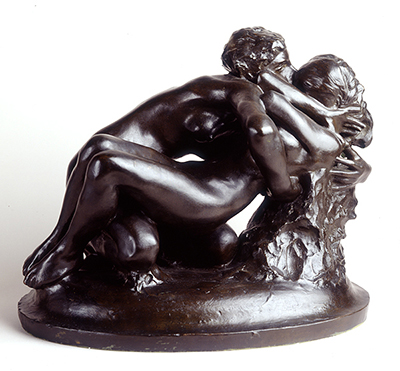Originally, Ovid's Metamorphoses formed a small part of a much larger work – Porte de L'Enfer (The Gates of Hell). Later, it was developed as a separate piece.
The Gates of Hell is a monumental (20 foot high) sculpture that was designed to be the entrance to a new Musee Des Beaux Arts in Paris. Unfortunately, the museum was never built. Rodin began work on the project in 1880 and continued with it for the rest of his life. The work, consisting of some 180 figures (including The Thinker, The Kiss and The Three Shades), was inspired by Dante's Divine Comedy, Ghiberti's Gates of Paradise and The Last Judgement of Michelangelo.
The plaster model is located in the Musee D'Orsay and the two bronze castings made after the death of the sculptor are housed in the Rodin museums in Paris and Philadelphia. Les Metamorphoses d'Ovide depicts a passionate embrace between two lovers and is based on the myth of the merging of Salmacis & Hermaphroditus as related in Book IV (l. 346 – 388) of Ovid's Metamorphoses. Hermaphroditus, the beautiful son of Hermes and Aphrodite, spurns the advances of the nymph Salmacis until she lures him to her sacred stream. There, they literally combine and unite male and female characteristics in one body. As can be seen from the sculpture, the figures appear to be mid-way through their transformation, limbs are entwined, the upper (male) figure appears to have breasts and the facial features of the reclining figure have melted.
Some commentators think that the passion depicted reflects the torrid affair that Rodin was having with his younger mistress, Camille Claudel. Alternatively, because the sculpture was variously entitled The Satyress, Voluptuousness and Friends, it merely reflects Rodin's general artistic concerns during this period rather than relating to a specific myth. Les Metamorphoses D’Ovide, similar in conception to Daphnis and Lycenion (1885), was conceived circa 1886 and was cast in bronze four times during Rodin's lifetime. The bronze has a brown and green patina and measures 31.1cm in height. Ten further castings were made after his death – two of which are housed in Museo Soumayo, Mexico City and Yamasaki Majak Museum of Art, Nagoya, Japan. Plaster versions of the piece can be found in the V&A, London and the Musee Rodin, Paris.




